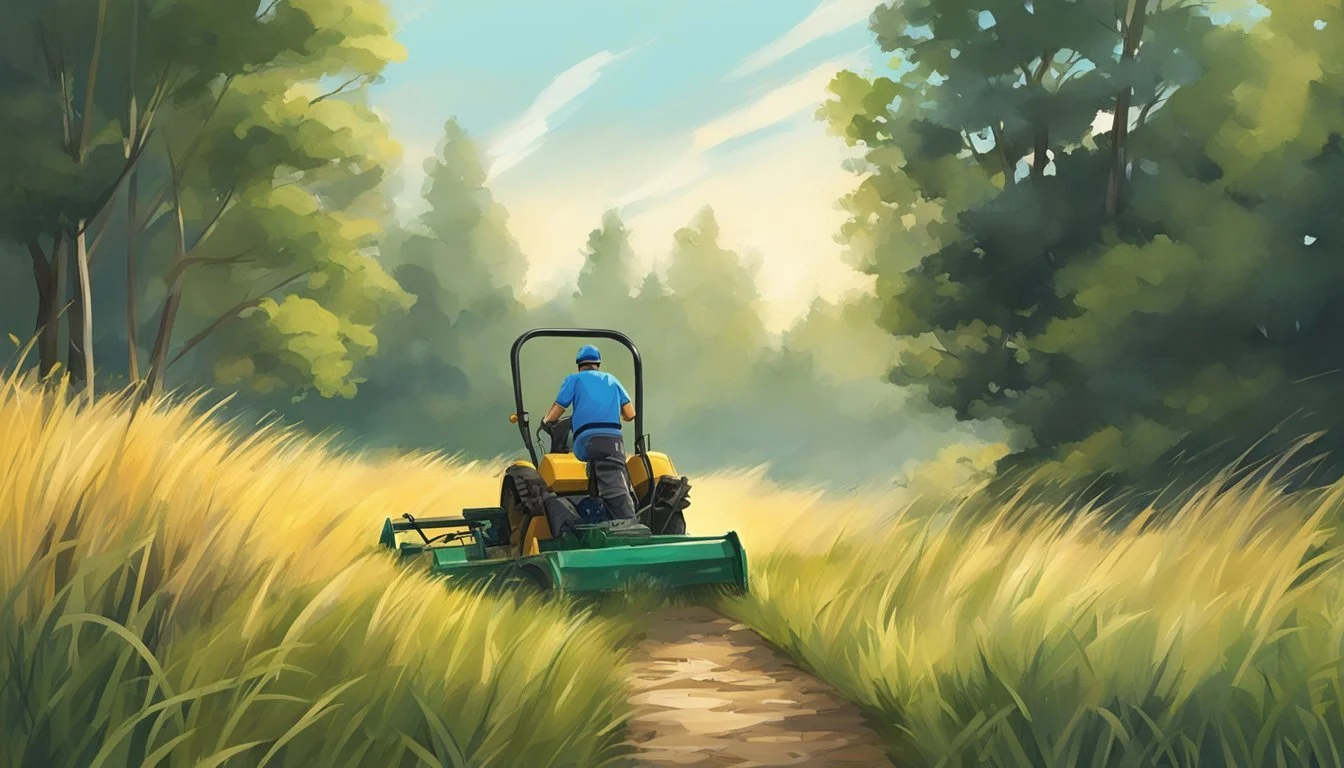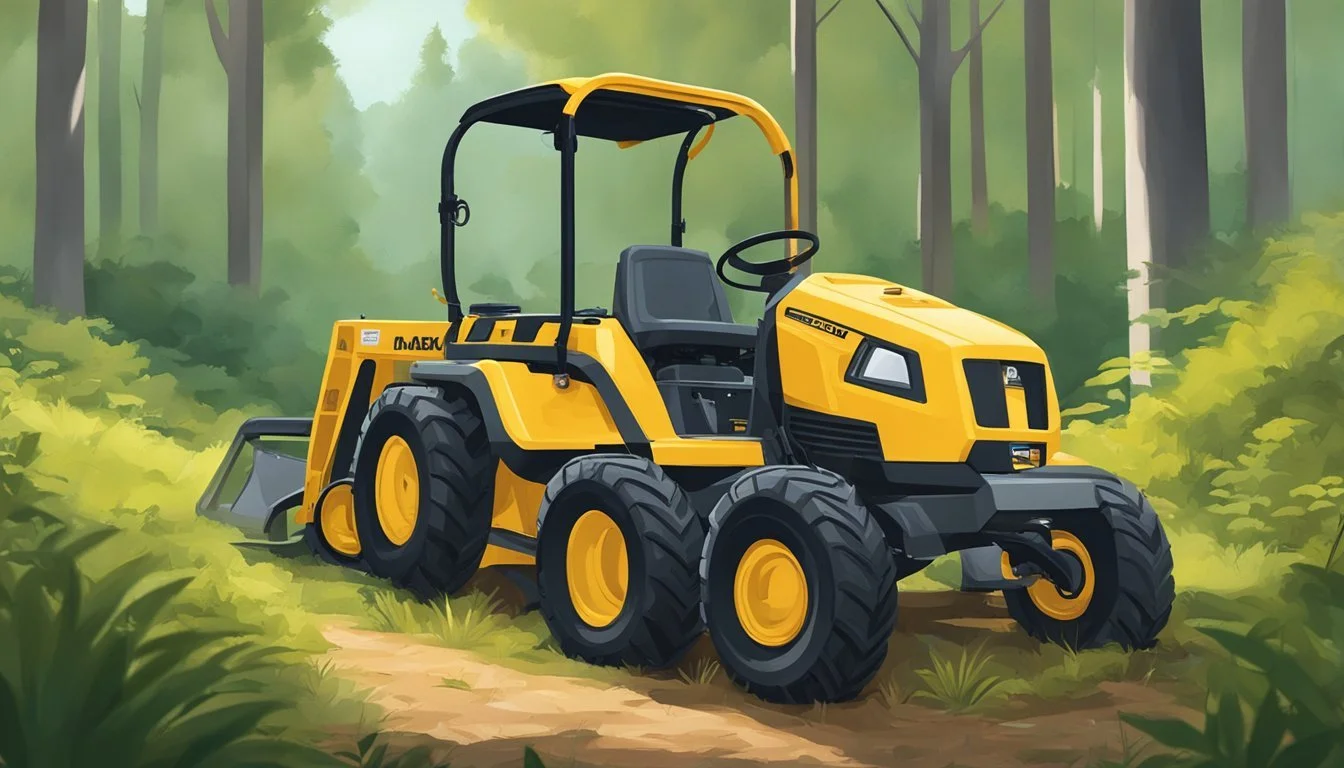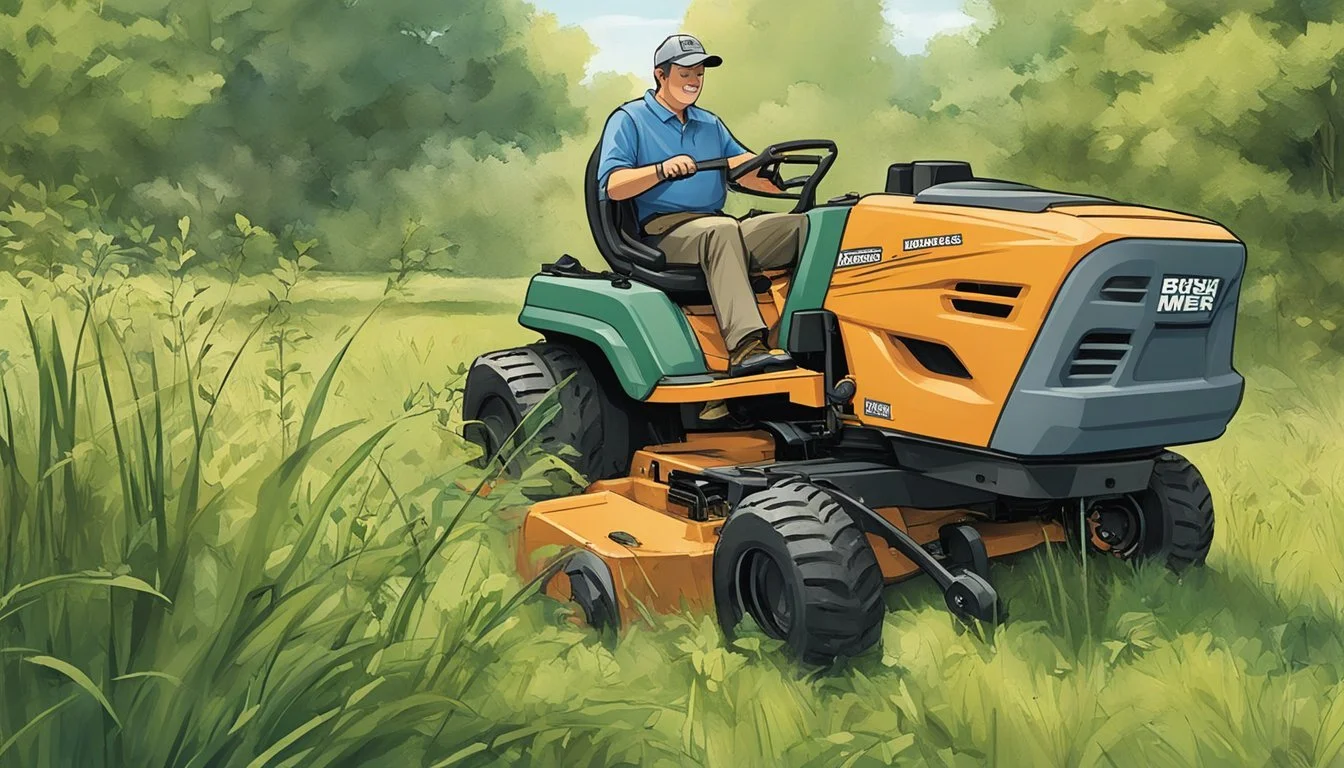The Ultimate Guide to Using a Brush Mower
Essential Tips for Homestead Land Management
Clearing overgrown land can be a substantial undertaking, especially for homesteaders looking to reclaim their yards and gardens from the clutches of nature. Brush mowers are designed to tackle such challenges, efficiently cutting through dense vegetation, tall grasses, and stubborn weeds that might have taken root. These powerful machines save time and labor, transforming an unruly landscape into manageable and usable land.
When considering a brush mower for land clearing, it's crucial to understand its capabilities and how to operate it safely and effectively. Unlike standard lawn mowers, brush mowers are equipped with heavy-duty blades and more robust engines to handle thick, fibrous plants and woody materials. They come in various models, including walk-behind and tow-behind types, each suited for different extents of overgrowth and terrain challenges.
Homesteaders must choose the right brush mower for their specific needs, taking into account the size of the area to be cleared and the thickness of the vegetation. By following best practices and manufacturer guidelines, one can clear overgrown areas on their property with precision, ensuring that the land is not only aesthetically pleasing but also functional for future landscaping or agricultural projects.
Understanding Brush Mowers
In the realm of land management, brush mowers are indispensable for their ability to tackle overgrown vegetation. Knowing the types, components, and selection criteria ensures efficient and effective land clearing.
Types of Brush Mowers
Walk-Behind Brush Mowers: Ideal for smaller areas, walk-behind mowers offer superb maneuverability. Users will find the self-propelled models significantly reduce physical strain during operation.
Riding Brush Mowers: For larger properties, a riding brush mower, such as the Orec Brush Rover, efficiently clears vast areas without exhausting the operator.
Tow-Behind Brush Mowers: These units attach to tractors or ATVs and are excellent for expansive, open land, providing wide cutting swaths with each pass.
Brush Mower Components
Blades: Standard on most brush mowers, these are suitable for cutting thick grass and modest overgrowth.
DuraBlades™: Engineered for tougher environments, DuraBlades™ can handle denser and woodier vegetation.
Beaver Blade: A chainsaw-like attachment, the Beaver Blade cuts through saplings and small trees with ease.
Selecting the Right Brush Mower
When choosing a brush mower, one must weigh the machine's cutting capacity against the property's demands. For example, heavier units, often around 1,500 pounds, necessitate a skid steer with the proper recommended loader capacity to handle the additional weight effectively. Adding options such as a rear roller can increase weight by 200-300 pounds, further influencing the necessary carrying capacity of the associated equipment.
Preparation and Safety
Before undertaking the task of clearing overgrown areas with a brush mower, it is essential to focus on comprehensive land assessment and safety measures. The proper precautions and preliminary workspace preparation can ensure efficiency and prevent accidents.
Assessing the Land
The land should be thoroughly assessed for uneven ground, hidden obstacles, or hazardous plants like poison ivy and poison oak. Identifying these hazards ahead of time is crucial. They should locate areas inhabited by wildlife, such as snakes, to avoid harm to both parties. It's recommended to survey the area and mark or remove objects that might obstruct the path of the brush mower.
Safety Precautions and Gear
Safety cannot be overstressed when operating powerful machinery. Individuals must wear protective gear, including gloves, goggles, and other body protection to minimize the risk of injury. Ensuring a first aid kit is readily available is imperative in the event of an accident. It is also advisable to familiarize oneself with the brush mower's manual to understand its specific safety features and operational guidelines.
Protective Gear:
Gloves: Protect hands from blisters and cuts
Goggles: Shield eyes from flying debris
Long Pants and Sleeves: Protect skin from thorny plants and insects
Sturdy Boots: Safeguard feet and provide better traction
Clearing the Workspace
Clearing the workspace involves the removal of debris, loose stones, and large branches that could become dangerous projectiles when hit by the mower blades. The workspace must be free of all obstacles that can cause damage to the equipment or pose a safety risk. This step not only aids in preventing equipment damage but also contributes to a more efficient mowing process.
Remove: Rocks, branches, trash
Mark: Larger obstacles and hazards that cannot be removed
Plan: Create a clear mowing path to follow
The Brush Mowing Process
Selecting the proper technique and equipment for brush mowing is crucial. The process varies depending on vegetation types and the challenges presented by the terrain. A brush mower is effective for dense foliage including grass, tough weeds, and undergrowth, transforming overgrown areas into manageable land.
Mowing Techniques
To mow effectively, one should utilize a consistent pattern and maintain a steady pace. For larger properties, a riding brush mower increases efficiency. Obstacles such as rocks or uneven terrain necessitate cautious maneuvering. Tough areas may require multiple passes, and for optimal results, overlapping each swath slightly ensures no vegetation is missed.
Start at the perimeter of the area and work inward.
Maintain a speed that allows the mower to cut effectively without stalling.
Use a systematic approach to ensure complete coverage.
Dealing with Different Vegetation Types
Each type of vegetation requires a specific approach. Grass and light weeds can be handled with standard brush mowers, while tough weeds and undergrowth may necessitate specialized blades.
For trees and thick brush, use mowers with heavier blades or chains.
Switch to lighter blades or trimmer lines for grassy areas to conserve energy.
Always consult the mower's manual for blade recommendations.
Handling Tough Areas
Challenging terrain with dense vegetation, rocks, and obstacles demands attention to safety and technique. For dense brush or trees, a high-powered brush mower with a durable cutting deck is essential. Additionally, adjusting the height of the mower can improve its performance on rough ground.
Inspect the area for hidden obstacles before mowing.
Employ a brush mower with an articulating deck for tighter turns around obstacles.
For sloped or uneven terrain, a mower with a low center of gravity enhances stability.
Additional Equipment for Brush Clearing
Beyond brush mowers, an arsenal of specialized equipment and tools can enhance the efficiency of clearing overgrown areas. Such tools range from simple handheld devices to powerful heavy machinery, each playing a pivotal role depending on the scale and nature of the job at hand.
Hand Tools and Attachments
Chainsaws: Equipped with a sharp chain, chainsaws are vital for cutting through thicker branches and trees during the brush clearing process.
String Trimmers: Ideal for trimming grass and small weeds; these handheld tools can access tight spaces where larger equipment cannot.
Hand Tools: A selection of axes, loppers, and machetes is often necessary for manually cutting through underbrush and vegetation.
Brush Cutters: More robust than string trimmers, brush cutters can clear dense brush with their strong blades.
Attachments: For those with a tractor or skid steer, attachments like a flail mower, rotary cutter, or mulcher can greatly expand their brush clearing capabilities.
Heavy Machinery for Larger Jobs
Tractor: Often employed in brush clearing, tractors may be used with various attachments, such as mowers and cutters, to handle larger areas.
Skid Steer: Highly versatile and maneuverable, skid steers can be fitted with mulchers, grapples, or saws for efficient brush clearing.
Bulldozer: For extensive and heavy brush removal, bulldozers can push over and crush vegetation with ease, clearing large plots of land.
Stump Grinder: After tree removal, stump grinders can obliterate remaining stumps, allowing the land to be leveled or repurposed.
The choices among tools and machinery are critical to tackling the diverse challenges of brush clearing, providing the necessary power and precision for both modest and extensive operations.
Clearing Specifics for Different Areas
When using a brush mower to reclaim overgrown terrain, one must adjust their approach based on the characteristics of the area. Specific techniques and safety considerations are vital for efficient and effective land clearing.
Clearing Wooded Areas
In wooded areas, the undergrowth can be dense and intertwined with saplings and mature trees. Safety is paramount; one should wear protective gear such as gloves, goggles, and long pants for protection against debris. Begin with:
Identify and mark mature trees to keep to avoid accidental cutting.
Assess the terrain for hidden obstacles like large rocks or ditches that could pose risks or damage the equipment.
Start clearing from the perimeter and work toward the center, removing smaller brush and fallen branches first to create a path.
Use a systematic grid pattern for thorough coverage, ensuring that no patches of brush are left behind.
Addressing Overgrown Lots
An overgrown lot can present challenges such as hidden debris, uneven ground, and invasive species. The approach here should be strategic:
Survey the area beforehand, removing any trash or large debris that could hinder the brush mower.
Set your mower to a higher setting initially, then make subsequent passes with lower settings for a closer cut.
For densely overgrown areas, a heavy-duty brush mower is recommended to cut through thick vegetation.
Progress in manageable swaths to maintain control over the mower and avoid overheating the machine.
Post-Clearing Activities
Clearing overgrown areas with a brush mower can be highly effective, but the work doesn't end when the last swath of underbrush falls. Proper debris removal and stump management are essential for achieving a usable and aesthetically pleasing area.
Debris Removal and Landscaping
After mowing, the landscape will likely be littered with fallen vegetation. This debris, including saplings and brush, should be gathered and disposed of properly. They may use methods like:
Burning: Conditions permitting, an organized burn can efficiently minimize large amounts of organic waste.
Composting: Suitable plant material can be composted to enrich the soil.
For landscaping, they should contour any uneven surfaces and reseed as needed to stabilize the soil and promote healthy grass growth.
Stump and Tree Removal
Stumps left behind by larger trees can present significant obstacles. Tree shears may be employed to cut trees flush with the ground, but for complete stump removal, they might consider:
Grinding: A stump grinder can effectively remove tree remnants below ground level, leaving the surface clear.
Chemical Treatments: There are products available to hasten the decomposition of stumps, although this is a slower process.
In clearing land, the goal should be restoring functionality to the environment while being mindful of their ecological impact.
Maintaining Cleared Land
After using a brush mower to clear overgrown areas, maintenance is crucial to ensure the land remains in good condition and prevent reovergrowth. Proper maintenance techniques and prevention strategies are key.
Regular Maintenance Techniques
Regular maintenance involves consistent monitoring and action to keep the land clear. One should create a schedule for mowing to keep grass at a manageable height. Trimming around trees, fences, and structures is essential to prevent hard-to-manage thickets from forming.
Visual Inspection:
Weekly: Check for new growth in cleared areas.
Monthly: Inspect for signs of pest infestations or diseases in plants.
Physical Maintenance:
Mowing: Bi-weekly during the growing season.
Trimming: As needed around structures and obstacles.
In areas prone to quick regrowth, one might consider mulching to suppress new weed growth. For larger properties, strategic use of controlled burning, under professional supervision and with proper permits, can effectively reduce biomass and seed banks.
Preventing Overgrowth Reemergence
Preventing the reemergence of overgrown vegetation takes a proactive approach. If mowing and physical barriers are not enough, one might consider chemical solutions as a method of control. This should be done judiciously and following all local guidelines to minimize environmental impact.
Chemical Preventative Measures:
Pre-emergent Herbicides: Apply before the growing season starts to prevent seed germination.
Post-emergent Herbicides: Use on visible weeds, following specific instructions for safe application.
Non-Chemical Measures:
Mulching: Apply organic or synthetic mulch to suppress weeds.
Ground Covers: Plant low-maintenance ground covers that can outcompete weeds.
It's important for the caretaker to make informed decisions based on the specific ecosystem and to avoid overreliance on any one method, instead favoring a diverse, integrated approach to land management.
Environmental Considerations
When using a brush mower to clear overgrown areas, it is critical to assess the environmental impact on local ecosystems, including wildlife habitats. The operator should plan their clearing activities to avoid breeding seasons and migration periods for local fauna to minimize disturbances to wildlife.
One should also recognize the potential of cleared areas to contribute to wildfire risks. Mowed vegetation, if left to dry on the ground, can become additional fuel for fires. Establishing and maintaining a buffer zone around structures can be beneficial for fire prevention, while mowed areas should be cleared of debris to reduce this risk.
Brush mowing, when done responsibly, can have several environmental benefits such as:
Preventing Soil Erosion: By cutting down only overgrown areas, one preserves grass and other plants that help hold the soil in place.
Promoting Plant Health: Removing densely packed vegetation encourages the growth of native plant species.
Reducing Pest Populations: Overgrown areas can harbor pests which can be mitigated by regular clearing.
However, the environmental impact extends beyond the immediate physical changes. Although brush mowers are efficient, their usage contributes to emissions that affect air quality. Using equipment with a lower carbon footprint or investing in newer, cleaner technology can mitigate some of this impact.
Ultimately, the operator must weigh the immediate benefits of land clearing against the long-term health of the environment. Every effort should be made to employ environmentally responsible practices that support the homestead's sustainability and the surrounding ecology.




